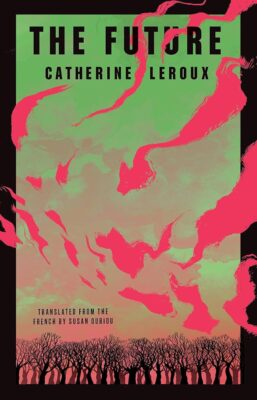Catherine Leroux’s latest novel presents a dystopian world located in a fictionalized version of Detroit. This Fort Détroit, rather than being ceded by the British to America in the 1783 Treaty of Paris, continues to be a francophone Canadian stronghold – “a site of resistance and liberty!” according to some of its residents. Resistance and liberty are two of the main themes that weave the stories of Fort Détroit’s residents together, and in learning more about their lives at the seeming end of the world, we find an ecosystem created not by shared history but by shared engagement.
The Future begins with two tragedies, brought on by the pervasive social ills that characterize a city in ruins. Gloria has moved into a home where she is forced to confront the gruesome death of her daughter and the mysterious disappearance of her granddaughters. She looks on in shock as her neighbour Eunice’s father is killed in a hit-and-run. Bonded by their mirrored grief, the women form a close friendship that extends into the fabric of Fort Détroit’s community. In a place shattered by violence, neglect, drugs, and the complete shutdown of public resources, members practice subsistence farming and lend each other tools and time while sharing food, information, and memories.

The Future
Catherine Leroux
Translated by Susan Ouriou
Biblioasis
$24.95
paper
288pp
9781771965606
Within this shared world, that is both outside of and deeply embedded within the world of Fort Détroit, the children set to work rebuilding social structures, sustenance practices, and even language. Called “wildlings” by the adults of Fort Détroit who know of their presence, the children are active participants in an ecosystem that is shaped by their fluid relationship to everything they encounter. Flora and fauna become friends and messengers; abandoned buildings serve as shelters. Food is sustainably stolen – a little at a time, so as not to risk detection by the adults – and order is maintained through consensus. This utopian world is not without its grief and violence, and in the end it appears that existing both inside and outside human civilization are equally impossible. But there is a graceful medium to be achieved in the space where the wild and cultivated meet.
Leroux brings believability, poetry, and hopefulness to the dystopian narrative of Fort Détroit by steering clear of the many pitfalls of end-times novels, which include overdramatic collapses, real-life characters put into speculative, fictional roles, and often a general preachiness. The city has not crumbled all at once, in a sweeping destruction, but rather through slow degradation. This permits the novel to imagine infinite small beginnings within the ending, and to show how destruction is balanced by the ever-present promise of creation. Like the incinerated house across the street from Gloria, which slowly regrows itself out of the ashes, and the vegetables that sprout strangely off the sides of the road, there is an impulse to life everywhere, particularly in the characters we meet.
Leroux’s work is characterized by a stark awareness of character and mood, a keen eye that is translated with deep sensitivity by Susan Ouriou. With an uncanny emotional precision, this novel shows once again the writer’s talent for presenting fleeting scenes that throw up a mirror to our own world. It is hard, for example, not to see ourselves and our innate human ability to turn disaster into a spectator sport when Gloria joins her neighbours to watch an abandoned house burn to the ground. With no firefighters available to answer the call, a small crowd gathers, and she notes that, from afar, they “could be mistaken for a huddle of concerned neighbours.” Yet, when she sees them up close, they instead resemble “a group of vacationers attending an outdoor concert.” Rather than turn away from the sight, she “drops into the chair … and, like the others, gives herself over to the spectacle.”
At various points, characters are confronted with some version of a dilemma that feels very contemporary: How do we look away from what is right in front of our eyes? This question is woven seamlessly throughout the novel, confronting readers with both the imminence of natural and social collapse, as well as the innateness of human resilience.mRb






0 Comments